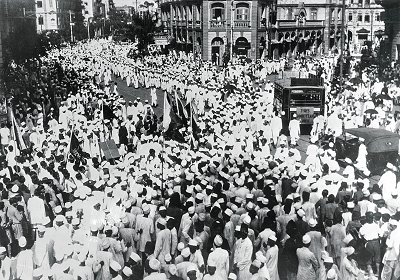Non Cooperation and Civil Disobedience Movements
by Dr. Jyotsna Kamat
First Online: July 17, 2005
Page Last Updated: December 07, 2024
In pursuance of his struggle for justice or Satyagraha, Gandhi accepted two 'tools' or methods which were based on complete non- violence. Non Cooperation was passive where civil disobedience was active and almost revolutionary. The non co-operation movement aimed at bringing the government to a stand still, by withdrawing every support to administration. The civil disobedience movement was planned to paralyze the government by mass support by undertaking acts which the British government considered illegal but were protests against exploitative and suppressive measures.
The "Non Cooperation Movement" (a.k.a. "Asahakar") in 1920's included surrender of titles, resignation from nominated seats in local government bodies, boycott of government educational institutions, law courts and foreign goods. Swadeshi also was included later.
The civil disobedience was organized against repressive laws. Gandhi, supported by Congress had started the agitation for reduction in land revenue, abolition of salt tax, cutting down military expenditure and levying duty on foreign cloth etc. But the British Government did not agree. They thought these were ' populist' schemes to win over different sections of the society.
Hence Civil Disobedience was launched in 1930, which is known as Salt Satyagraha or Dandi March. Salt law was broken, Gandhi was arrested along with his followers. It stirred the whole nation. Almost all the coastal towns witnessed breaking salt law.
Corbis/Bettmann/Kamat's Potpourri
Massive Rally of Protestors
A two mile long rally of Indians in Bombay protesting the arrest of Gandhi, 1930
Side by side, the Jungle Satyagraha ( breaking forest rules, cutting trees) started, as also no-tax campaign. The tax levied was too high, varying from 22% to 60%. The Bardoli Satyagraha started under the leadership of Vallabhai Patel which won him the title of "Sardar" or "The General". The government had to bow before popular resistance.
Karnataka was in the fore front in the Salt Satyagraha, Jungle Satyagraha and No-tax campaign. Bombay presidency (Gujarat and four districts of Karnataka were part of it). Uttar Pradesh Presedency and Madras Presidency were leading in the agitations.
This campaign reached the far off province of North West. Khan Abdul Gaffar Khan emerged as the leader of Pathan community. His Khuda Khidmatgar (servants of God) became an organization completely based on non-violence. The fiery tempered Pathans exhibited such restraint and self confidence that they set an example to the whole nation.
The role of women in all these movements was outstanding. They were in the fore front of Civil disobedience. They excelled as speakers, marchers, picketers and tireless volunteers. Famous among them were Mani Ben Patel, Rajkumari Amrit Kaur, Kamala Nehru, Durgabai, Bharati Devi Ranga and Kamaladevi Chattopadhyaya.
The whole country was united as never before under Gandhiji's leadership. He was a shrewd judge of men and events. All the lieutenants he chose became national leaders: C.R. Das, the Bose brothers, Abdul Kalam Azad, the Nehrus, Patel brothers, Rajendra Prasad, Acharya Kriplani, Dr. Ansari, C. Rajagopalachari, T. Prakashan, V.O. Chidambaram and a score of others.
![]()
See Also:
- History Potpourri -- Social and political history of India; includes history of freedom struggle, history of drinking, history of education, dynasties, and religious movements
- India's Freedom Struggle: The Quit India Movement
